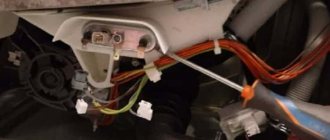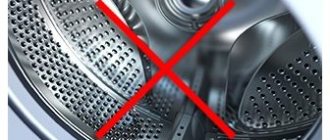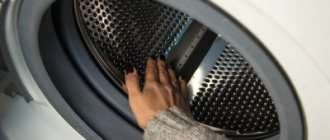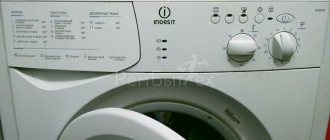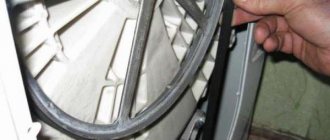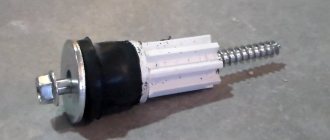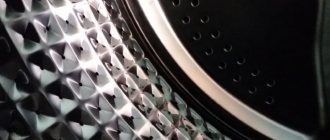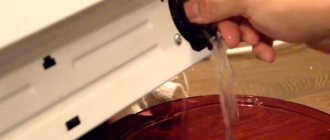Despite the fact that a modern automatic washing machine is a very technologically advanced and complex device, it has key blocks. The most important of them is the drive drum. The correct performance of most washing operations depends on the serviceability of the components of this functional unit. If the washing machine does not spin the drum, it will not be able to start washing and spin out the laundry efficiently, and will completely lose its suitability as a home helper.
Why did the drum stop?
To understand why the drum stopped rotating, you need to analyze how the washer worked before it stopped and diagnose the equipment. It is necessary to find out the cause of the malfunction and take measures to eliminate it. Usually the main container “freezes” in place due to:
- problems with the drive belt or drum “wheel” (perhaps the reason is both the rubber band and the pulley);
- a foreign object that has fallen inside the tank. It gets stuck between its walls and the drum and blocks the rotation of the latter;
- failure of the engine coil;
- severe wear of the motor electric brushes. The carbon rods wear out and cannot fully perform their functions;
- damage to the semiconductor elements of the main control module;
- erasing the motor slats.
The list of reasons why the washing machine may not spin the drum is far from complete. The simplest washing machine is a whole set of components, circuits, connections, and individual elements, the failure of which can cause the rotation to stop.
You should start self-diagnosis of your Beko machine with the simplest thing, discarding the reasons one by one. If you encounter difficulties checking individual components, you can seek professional help.
Foreign body in the tank
Equipment repair technicians tirelessly talk about the danger caused by foreign solid objects that get into the washing machine tank. They tell how expensive repairs such a situation can turn out to be. Despite this, users often forget to check their pockets before loading items into the drum and neglect the recommendation to wash bras in special bags. Then, coins, pins, nails, paper clips, bones from bodices, and buttons get stuck between the tank and the drum.
It wouldn’t be so bad if the objects lay quietly at the bottom of the tank. However, sometimes they cause the drum to wedge and can cause damage to the plastic tank. In this case, you will have to replace the entire assembly, and this is a rather expensive repair.
If the drum is jammed for this reason, do not try to unscrew it manually or start the wash cycle. It is important to remove the stuck object from the washing machine tub as soon as possible. This can be done through the hole in the drain pipe or heating element.
If on your Beko model the heating element is located in the rear of the case, then it is better to get to the stuck small items in this way. It is necessary to remove the service hatch of the machine, disconnect the power supply from the heating element, loosen the fastening nut and pull the heater out. The resulting hole is enough to easily remove from the tank an object blocking the rotation of the drum.
When the heating element is in front, it is better to discard the idea of reaching a foreign object through its opening. This will involve removing the front panel of the case, which is quite difficult to do. It is much easier to try to remove stuck small things as follows:
- drain the water from the system through a garbage filter;
- lay the machine gun on its side;
- loosen the clamp securing the drain pipe, disconnect the hose from the tank;
- remove the foreign object through the drain hole.
After the problem is resolved, check the drum movement. If it rotates freely, you can assemble the Beko machine and continue to use the equipment.
What can you do right away?
We calm down, turn off the machine with the button on the panel and unplug the cord from the outlet. We cover the floor with rags, find the drain filter on the front panel below, place a container (scoop, suitable container) under it, open it and drain the water. We take the laundry out of the machine and figure it out further.
We determine when the drum stopped. If during the spin cycle, the laundry will remain simply wet, without any signs of soapiness. If you wash it, things will be powdery.
You need to try to spin the drum by hand. Did not work out? Rotation is physically interfered with by a foreign body or a failed part. When the drum spins while the machine is turned off, the reason is hidden in the electronics.
The drain filter plug is unscrewed counterclockwise, and if you can’t pull it out by hand, you can use pliers
And one moment. A common consequence of drum immobility is the usual overload. Try splitting the laundry in half and restarting the wash with less “work.”
Modern washing machines are equipped with special sensors that monitor the weight: if it is exceeded, they stop the process. On some models this information is displayed on the display.
Don't forget to check the external conditions that affect the operation of the machine. Some washing machines are equipped with sensors that are sensitive to water pressure parameters.
While the user is disassembling the device and changing parts, a pinched hose, a burst gasket or a dirty filter will not alert you to attention.
How to fix the situation
What should I do to troubleshoot? Let's look at the problems and their solutions.
Imbalance
To correct the imbalance, you need to stop the program. If there is water in the tank, it must be drained. To do this, unscrew the drain filter - it is located behind the hatch under the front panel. Read more about how to do this below.
Now open the hatch door and distribute the laundry evenly throughout the drum.
Blockage in the system
To clear a clog in the drain filter, proceed as follows:
- On the front panel below, open the small hatch by releasing the latches.
- Unscrew the filter, drain the water into a container and clean the filter from debris.
- Reinstall the part.
Belt problems
In order to check the drive belt, you need to remove the rear panel of the CM. Proceed sequentially:
- Remove the plug from the socket, turning off the power to the machine.
- Turn off the water supply and disconnect the intake hose (be careful, there may be water in it).
- Take a screwdriver and unscrew the screws on the back cover.
- After removing the panel, inspect the belt. If it frays or falls off, it needs to be put back in place. In case of wear, a new element is put on.
- First put the belt on the small pulley of the electric motor, then, while simultaneously turning the drum pulley, put the belt on it.
- Installation is complete, screw the panel into place.
Heating element malfunction, foreign object
These two problems can be resolved simultaneously:
- Remove the back cover as described above. In some models, the heating element is located behind the front panel: Samsung, Bosch, Siemens.
- There is a heating element under the tank. To check it, you need to connect a multimeter to the contacts and measure the resistance.
- When you are convinced of the malfunction, disconnect the wires from the heater.
- Unscrew the central nut (not all the way) and push the bolt inward.
- Prying the edges, pull the element out.
- Now you can check through the hole to see if there is a foreign object inside and remove it.
- Install the new heating element in reverse order.
Engine problems
You don't have to put the panel back in place since the motor is also at the back. Inspect its wiring for damage.
Then you need to remove the engine to inspect the brushes and other parts.
- Disconnect the motor wires.
- Unscrew the mounting bolts.
- Pull out the motor and its brushes. If they are worn out, new parts need to be installed. The same applies to lamellas and windings. They are checked last, if everything is in order with the brushes.
- Inspect the tachogenerator. It is mounted on the engine housing. If faulty, replace.
The main module burned out
It is difficult to repair electronics yourself, but it is possible to inspect them for damage.
- Unscrew the two screws at the back and remove the top cover.
- Remove the powder dispenser tray by pressing the latch in the center.
- Unscrew the control panel mounting bolts.
- Unclamping the latches, remove the panel from the SMA body.
- Inspect the wiring for integrity. Unclench the clamps and, having disconnected the panel, inspect the control board.
- If burnt parts are visible on it, it means repair or replacement is required.
- You can replace the element. Reinstall the new module, connect the connectors, and secure the panel to the chassis.
All parts in the washing machine can be replaced independently, but not everyone can cope with their repair. If you are not confident in your abilities, contact the service center.
Source
Features of Beko washing machines
The Turkish brand has proven itself quite well in the Russian household appliances market. Compared to other global companies, the manufacturer is able to offer the buyer a quality product at an affordable price. The models are distinguished by their original design and the necessary set of functions. A number of features of Beko machines can be highlighted.
- Various sizes and capacities, allowing anyone to choose exactly the device that is most suitable in a particular case.
- Thoughtful software set. Provides quick, hand, gentle wash, delayed start, washing of children's, dark, woolen items, cotton, shirts, soaking.
- Economical consumption of resources. All devices are manufactured with class A+ energy efficiency, ensuring minimal energy consumption. Water consumption during washing and rinsing is also minimal.
- Possibility to select spin speed (600, 800, 1000) and washing temperature (20, 30, 40, 60, 90 degrees).
- Various capacities - from 4 to 7 kg.
- The safety of the system has been thoroughly developed: complete protection against leaks and children.
- When purchasing such equipment, you pay for the washing machine, and not for the brand.
Drum stopped during washing
There are many reasons why the drum stops during the washing process - first of all, it is worth checking the selected program: when choosing the delicate mode, a small amount of water will remain in the tank in any case. Due to this, you may mistakenly feel that there are problems with your work.
The washing machine can stop the washing process if a lot of things have accumulated on one side of the drum, which only load one side. In this case, strong vibrations occur. At the same time, the electronic control unit gives a signal to stop the wash, because imbalance can lead to mechanical damage to device elements and serious breakdowns.
Clogged hoses or a breakdown of the water level sensor in the tank can also cause the washing process to stop.
Ask a Question
Always pay attention to the display - modern machines display error codes on it, the explanation of which can be found in the instructions. Knowing the code, you can find out exactly in which node the problem is hidden and protect yourself from unscrupulous repairmen trying to “inflate” the cost of repairs by adding a bunch of unnecessary services to the receipt.
Washing cannot proceed without heating the water, so if the heating element malfunctions, the temperature sensor will give a signal to stop washing and the drum will stop along with the laundry. Touch the glass of the door: if it is cold, although the heating mode is selected, then there is a problem with the heating element, most likely it will have to be replaced.
The same is true in the opposite situation - if the water temperature sensor is faulty, then the washing will be completed, since the control unit cannot monitor the current state and, accordingly, give a signal to continue working.
Bearing failure
An emergency stop of the drum can also occur due to a bearing failure. When disassembling the drum, you need to check the integrity of the bearing and seal lip; by the way, they can be replaced immediately.
Wear can be determined by the sound of the machine; a worn bearing makes a grinding, clanging, knocking sound. In addition, the machine begins to vibrate strongly during washing. All this indicates that the bearing is worn out and that it is time to replace it.
To remove the bearing, it is permissible to use available tools. After it is dismantled, grease is driven into its installation site. Before removing the worn bearing, it is necessary to disassemble the washing machine. This procedure will require ordinary plumbing tools. With its help, you need to remove the front cover, dispenser, and automatic control. Each of the blocks is secured with screws or plastic clips; they must be removed before removing parts and assemblies.
After the front panel and other components are removed, you can remove the back and top covers. The counterweight is then removed. All this is necessary to gain access to the bearing assembly.
When disassembling the washing machine, it is imperative to dismantle the pipes, in other words, remove everything that is necessary for free access to the bearing assembly and the connection between the drum and the tank.
Immediately before removing the assembly, which includes the tank and drum, the electric motor is removed from the housing. Now you can begin disassembling the tank-drum assembly. After the assembly is removed, it is advisable to move it to the workbench. Next, the bearing and cuffs are removed, lubricant is filled in and new parts are installed.
When assembling the drum, special care must be taken; the joint must be treated with sealant, this is necessary to prevent leaks.
Transmission mechanism
What actions to take first? In most cases, the Beko stops turning the drum due to problems with the drive belt. The rubber band may have broken or fallen off. If this is a one-time “promotion”, then it will be enough to buy a new element, remove the back panel of the washing machine and pull it onto the drum and motor pulley.
If the drive belt falls off regularly even after replacement, you will have to “dig” deeper to rule out pulley failure.
A new rubber band that comes off the “wheel” again after a few washes is a symptom of a serious problem. To check for damage to the drum pulley, you must:
- turn off the power to washing equipment;
- turn off the shut-off valve responsible for the water supply;
- pull out the washer to gain access to its back;
- remove the service hatch or rear panel (depending on the Beko machine model);
- inspect the drum pulley (represents a large wheel). If it is in perfect condition, you can tighten the drive belt into place. If there are any defects or deflections on the surface, the circle will have to be changed;
- take a look at the pulley mounted on the motor shaft. If the circle is deformed or damaged, be sure to reinstall the wheel.
If you find signs of wear, cracks, bends and other defects on the pulley, it is better not to put off replacement. In fact, reinstalling the drum wheel is not difficult; even a beginner can do it. All you need to do is purchase a similar circle, unscrew the fixing bolt, remove the damaged element and put on a new one. Let's analyze the upcoming algorithm of actions in more detail.
- Using a wooden block, block the movement of the drum “wheel”. If the circle is deformed, then there is no need to take care of it. It is important to preserve the screw and threads during the process, so you should proceed carefully.
- Spray the center bolt with WD-40. Wait half an hour for the substance to take effect.
- Take a wrench of a suitable size and carefully unscrew the screw. In this case, you do not need to press too hard on the structure so as not to damage the bolt and thread.
- Remove the old "wheel".
- Place the new pulley on the shaft and secure it with the mounting bolt.
Experts recommend replacing the drive belt at the same time as the drum pulley.
There is nothing difficult about replacing a wheel. It is very important not to overdo it here, so as not to break the thread. When the Beko machine repair is complete, check with your hand how freely the drum rotates, then run a test wash.
Reasons why the washing machine drum stops and how to eliminate them
The control module is broken
The drum may remain motionless due to the lack of a signal from the “brain” to start washing. Most often, the control board fails due to voltage surges or natural wear.
Electronics fail for several reasons:
- the supply current parameters deviate from the permissible limits;
- low-quality elements of electrical circuits;
- violation of contacts;
- natural wear and tear;
- program failure.
Initially, you should try to reset the programs. Some washing machine models have a self-test function; by running it, you can determine the cause of the problem. If performance is not restored, removal and diagnostics of the electronic unit will be required.
There are three options to solve the problem - reset the programs, flash the firmware, or replace the module.
Some models have a self-test function. It allows you to determine the source of the problem. How to enable this feature? They don’t write in the instructions, but the starting method depends on the manufacturer and the specific model.
As an example, during repairs, an Ardo washing machine is tested as follows: drain the water, the tank should be empty, set the mechanical program switch vertically down, and set the temperature to zero. To start the test mode, press all the buttons at once.
Each machine has its own way of turning on auto-test: LG - by holding down the power, temperature, spin keys, and then you need to press start three times in turn to test the operation of the drum.
If there is still a need to remove the board, it can be removed quite simply. We remove the top panel, dismantle the upper part of the machine, remove the fixing strips and take out the module.
Repairing the control unit requires special skills - you need to check the parameters of the elements and monitor the chains. We carefully inspect the board.
Remove the board yourself only after the warranty period has expired, and if you do not have the skills for such repairs, you can replace the entire control unit
4 signs that serious intervention is needed:
- The paths darkened, the color changed in some places, and scorch marks appeared.
- Bumps are visible on the caps of the capacitors.
- The varnish coating on the damping coils has faded.
- The main processor has darkened at the installation site.
If any of the above is found and you have no experience with a soldering iron or multimeter, entrust the repair to a specialist.
Failures associated with sensor problems can be resolved independently. Contact groups become greasy and clogged over time; they just need to be cleaned. Remove the program regulator, disassemble the handle and clean it.
If there is a layer of soot on the power coils of the surge protector, brush it off with a dry cloth and brush. We free the hatch lock block from soap deposits.
A belt drive has fallen off or broken, how to identify and repair it
The transmission of rotation from the electric motor to the drum is carried out using a belt drive. A belt breaking or slipping off the pulleys disrupts the connection between the elements. In this case, the drum rotates freely by hand, and the motor hums when voltage is applied.
If the drive belt is deformed, the rotation of the drum will be completely stopped. In many cases, the belt may simply “jump” off its pulley due to strong vibration that occurs during spinning. To restore functionality, it will be enough to remove the back cover and install the belt in its place.
To fix it you need to get to the engine and large pulley. Washing machines use V-belts or poly-V-belts. To install, you need to loosen the engine mount and ensure that the grooves of the mating parts match.
Remove the back panel of the machine and look at the condition of the belt. If it just slipped off, put it back in place, close the lid, turn on the washer and check its operation. In case of complete wear or damage, replacement will be required.
Machines with asynchronous motors have V-belts, while those with commutator motors have V-belts. The first ones are trapezoidal in cross-section and are marked on the outside. This is exactly what is shown in the picture.
They are made of chloroprene rubber, polyester cords, and cotton material, due to which they are elastic and have increased strength characteristics.
The V-belt is tensioned when moving the engine, so you need to loosen the fastenings. When the adjustment stroke of the engine is small or such a maneuver is excluded by the design of the machine, the belt needs to be replaced.
We install the V-belt like this: we wind it around the pulley, then we place the strip in the drum groove and seat it completely there, rotating the pulley.
The tension of the V-belt should be very tight: if you press hard in the middle, a deflection of up to 5 mm is considered normal
The V-belt has a toothed section. The parameters are also marked on the outside. It changes in exactly the same way as the wedge one. But it requires careful position control after final installation.
We measure the middle of the mating part of the engine pulley and drum - the belt is installed strictly along this line. V-ribbed belts are tensioned less than V-belts.
In all other cases, stretching or breaking of the belt requires replacing it with a new one. When choosing a belt, you should pay attention to the original or a worthy analogue if you want the machine to last a long time. A Chinese fake will quickly stretch or tear.
Washing machine electric drive failure, how to fix it
If the drum not only does not rotate in the car, but also does not hear any sounds of a running electric motor, this is most likely the problem. A slowly rotating drum can also indicate engine malfunctions.
In older engine models, the problem is often the starting capacitor, which is shaped like a cylinder and mounted next to the drive. If the capacitor fails, the engine does not start, which is why the drum does not rotate. Replacing the capacitor will help with this problem.
In commutator motors, a common cause is brush wear. Over time, they wear out and become shorter, and therefore the required contact with the lamellas of the engine manifold is not achieved. And the drive does not work simply for the banal reason of lack of voltage on the windings.
To fix this problem, you will have to replace the brushes.
To diagnose and repair the engine, it will have to be dismantled. The work is carried out as follows:
- To remove the motor, you need to remove the back wall of the washing machine by unscrewing the fastening screws.
- Then the drive belt is carefully removed.
- The engine is located on the underside of the machine. To remove it, screws are unscrewed; there may be two or more of them.
- Next, the contact block connecting the electric drive to the control unit of the washing machine is disconnected. If there is a separate ground wire screwed directly to the machine body, remove it too. The removed engine is pulled out.
- Then you need to unscrew the locking screws and pull out the brushes on one side and the other. The brush is considered worn out and unsuitable for further use if no more than 15 mm of its length remains.
- When dismantling old brushes, you should remember in which direction their edges are ground - the new components should be installed in the same way. New brushes must match the model of the washing machine and be of the same quality. If brushes with different hardnesses are installed in the electric motor, it will very quickly fail again.
- After the brushes are in place, you need to spin the motor rotor. If you feel interference or make a lot of noise, the brushes may not be installed correctly. It’s better to check right away - unscrew and reinstall them correctly.
Another possible cause of engine failure is its combustion, which occurs when the winding is shorted between turns or breaks on the rotor or stator. This requires only a qualified approach.
In the event that a burning smell is felt during washing or smoke appears, the power is immediately turned off. And the engine will most likely have to be replaced. If you wish, you can, of course, try to rewind the burnt winding.
However, as practice shows, it is most often impossible to return the engine to factory quality using such measures, which means that after repair it will not last long. Therefore, if the engine burns out, it is recommended to install a new mechanism. Moreover, completely rewinding the engine is also quite expensive, and the material gain, if there is any, will be very insignificant.
The bearing is stuck, symptoms and troubleshooting
The rotation of the drum may stop due to wear of the support bearing. Depending on the design of the washing machine, there may be one or two of these elements. After long-term use, worn out oil seals begin to leak water, corrosion occurs and the bearing jams.
When water gets in or is overloaded with laundry, the drum bearings are destroyed, of which there are always two in the machine, regardless of whether it is loaded vertically or horizontally. Some models use double. But in essence, these are two bearings combined into one housing.
Sometimes situations arise when they overlap. This most often occurs with double bearings.
Determining bearing failure is quite simple. If, when trying to turn the drum manually, it does not move or turns tightly, and this process is accompanied by creaking and grinding noises, then these are the main signs that the bearing and oil seal of the drum axle shaft are damaged.
The problem is solved by completely replacing worn out elements. In addition to the bearing itself, the seals also need to be replaced. We treat the bearing installation site with lithol and return the elements back. Secure with a hammer.
The average service life of these parts is 7 years, after which they need to be completely replaced, otherwise problems will arise when washing.
The oil seal is a rubber insert designed to provide an airtight seal that protects the bearing from water ingress. However, over time, the seal wears out and the tightness of the assembly is compromised.
Moisture begins to penetrate the bearing, washing away the lubricant from it, leading to the occurrence and development of corrosion. Because of this, the rotation unit fails and the drum jams.
To replace the bearing, you will have to almost completely disassemble the machine and remove the tank.
The first step is to remove the cover of the machine - it is usually secured with two screws on the rear panel. Its dismantling is necessary so that dismantling can continue on the façade side. You can immediately unscrew the screws and remove the back wall of the machine.
After this, the upper control panel is unscrewed (or removed from the plastic stoppers, depending on the model) and removed. Here you need to act very carefully, since it is connected by cables (wire handles) to other components and devices of the washing machine. It is best to disconnect all connectors - they are usually made in such a way that it is impossible to make a mistake when connecting them back - they have different sizes and colors.
Next, the front panel of the car is removed along with the hatch door. It should also be dismantled carefully, since due to inexperience, some people forget to remove the connector from the hatch locking device (UBL). This lock is located on the right side of the door in the space behind the panel.
After the internal space of the machine is opened, the heating element is dismantled and all communications going to the tank are disconnected. Next, the massive counterweights are unscrewed and removed.
The drive belt is removed and the engine is dismantled. The heating element is removed. The tank of the machine is disconnected from the water supply and drain pipes, top and bottom.
Then the lower shock absorbers are unscrewed and moved to the sides, and the dismantling is completed by removing the upper suspension springs. After this, nothing should hold the tank in the body - it can be taken out and placed on the floor with the pulley up.
The next step is to remove the drive pulley. It is fixed on the axis on splines, secured with a nut (in some models - with a screw or bolt). Usually the nut is screwed on quite tightly, and it can be difficult to remove it, especially if there has been a water leak here. Therefore, it is recommended to generously moisten the joint with a compound such as WD-40 and leave for half an hour.
Then the pulley must be stopped (for example, with a wooden block), and a striking force with a hammer can be applied to the wrench placed on the nut. After the nut is loosened, it is completely twisted, and then the pulley is removed from the axle shaft.
Now we have to disassemble the tank - otherwise there is no way to pull the drum axle shaft out of the bearing assembly. If the tank is collapsible, then all the latches are removed in a circle, and the fasteners holding the halves together are unscrewed. If the tank is a non-demountable structure, then it is better not to do anything yourself.
The fasteners are unscrewed, the stoppers are removed - and the tank is divided into two halves, opening access to the drum.
After disassembling the tank, the axle shaft is driven inside through a wooden block from the outside - it should come out along with the drum. Now the rotation unit is completely open, and you can remove the bearings and seals. This is done very carefully so as not to deform their installation socket.
After this, the seat freed from the old bearing is cleaned and treated with lithol. Oil seals and new bearings are installed in place.
The bearing is carefully pressed into the seat with a hammer. It is better to carry out this process through a wooden plate, so as not to accidentally damage either the metal part or the plastic of the tank.
After replacing the bearings, the assembly process begins in reverse order. In order not to make a mistake in the sequence, you can photograph the dismantling process.
The electric motor brushes are worn out, how to determine the replacement procedure
The motor brushes of a washing machine may, over time, stop performing their direct function - creating the proper electromagnetic field to rotate the motor rotor. During operation, they gradually, quite slowly, wear out and the induction field from them weakens.
The problem is unique to commutator motors. Currently, they are installed on 85% of washing machine motors.
Usually brushes last for 6-8 years. The service life depends on the frequency of operation of the machine, compliance with recommendations for loading the drum, and the quality of assembly of the unit.
There can be no repairs here other than replacing the brushes. If you have the skills of an electrician, you can change the motor brushes yourself.
But measure the bars first: if they are longer than 1.5 cm, the brushes are not causing the drum to stop.
Be sure to buy two identical, matching models and brushes without defects: installing parts with different hardnesses can result in engine failure.
If the machine is assembled, remove the back wall and belt. We disconnect the engine from the power supply by pulling out the connector with the wires. We dismantle the engine itself.
Next, we lay the engine on its side so that the brush housing is on top, and unscrew the mounting bolts and pull out the spare part from one side and the other.
It is highly advisable to replace them before they are completely worn out. This will help avoid a number of problems - damage to the collector lamellas or the electronic module.
Also, do not forget to clean the collector from black deposits; remove scratches with sandpaper. That's it, now you can install new elements and tighten them with bolts.
The washing machine motor burned out, how to determine it and what to do
In this case, two options are possible: the engine is completely faulty and does not start, or rotation occurs only without load. The winding short-circuits or it breaks off at the stator and rotor.
A characteristic sign of the first situation is that the empty drum rotates normally, but during a full wash the plugs are knocked out. When the second situation occurs, the drum stops rotating altogether.
Repair is possible if the drum has stopped, but the machine is humming when turned on. A complete engine replacement is needed when there is no starting at all, there is a smell of burning, dark smoke, and sparks.
An electric motor is a fairly reliable unit, but it can also stop. Main reasons for refusal:
- wear of commutator brushes;
- short circuit of winding turns;
- winding breakage at the stator or rotor;
- failure of voltage supply contacts.
For diagnostics, the motor is removed and connected directly to the electrical network. To limit the speed, a resistance is used - a heating element. If there is a malfunction, it must be replaced with a new one.
If the winding is damaged, you can rewind it or replace it with winding from another similar motor. After this, the engine will continue to work without any problems.
The fastening systems differ in different models, but the principle is the same - the retaining bolts must be removed. Also, do not forget to disconnect the motor power terminals. The picture shows the bolts
The motor is removed in the same way as when replacing the belt. If it is clamped by the tank, slightly lift the tank and free the engine. Sometimes you have to remove the side wall as well. There are three main faults - brushes, lamellas, windings.
We have already looked at how to replace brushes. You can check the performance of the windings with a multimeter by probing adjacent lamellas one by one. The discrepancy must be less than 5 ohms.
We will also check the short circuit of all windings: we will place one probe on the body, and with the second we will go through the lamellas. If everything is fine, the resistance will be high.
It is easy to determine the unsuitability of the lamellas - completely remove the rotor from the engine, inspect the collector for the presence of burrs, peeling, and broken contacts
If the windings are faulty, it is better to find the same part and replace it. Rewinding will cost more. Minor peeling of the lamellas can be turned on a lathe.
More: Which drum is good for washing?
Foreign object in the tank, signs and solutions
This state of affairs sometimes happens. Things or parts thereof are pulled into the gap between the cuff and the drum. If they are small, they reach the drain pump and block its operation. Otherwise, they are wound on the heating element, shaft or cross.
If the drum is jammed, and there is a suspicion that this was due to a foreign object, then you should try to determine the location. For a better view, you will have to stick your head into the hatch of the machine, and place the switched-on flashlight on the bottom of the washing chamber so that it can illuminate the interior space.
If the obstacle is not visible, or it cannot be reached through the hole in the drum, you can try to remove it through the niche in which the heating element is installed.
In most models, the heating element is installed under the front, but in some - under the rear part of the drum. Accordingly, to get to it, you will have to remove the front or back panel of the case.
Removing the back panel is much easier; you simply unscrew the mounting screws from it and remove it to the side. To remove the front panel, you first have to remove the top cover of the machine and remove the rubber cuff on the round opening of the hatch.
The doors opened in a vertical washing machine, how to fix it
This reason is inherent in top-loading washing machines. If you do not fasten the curtains tightly, they open when they rotate. The laundry falls out. And all this is hooked, as a rule, onto the heater. The washing machine drum cannot spin.
Before washing, the metal doors of the drum are fixed together with a reliable latch. But over time it wears out, which can lead to their opening.
The extent of damage in such a situation will depend on the moment the doors are opened.
If the opening occurred during the “Delicate Wash” mode, then, as a rule, serious damage does not occur. If the doors are opened while spinning clothes, when the machine is running at high speeds, then damage to the tank and deformation of the drum are inevitable. In addition, the heating element may also come under attack.
The worst consequences of this phenomenon can be deformation of the drum and even destruction of the tank.
After stopping, you can try to turn the drum by hand until the loading hatch appears. If the doors open at low washing speeds, you can try to return the washing chamber to its original position.
Sometimes a metal meter ruler or a stiff wire helps - its diameter should be such that it fits freely into the drum hole. The end of the wire must be bent into a hook. You need to push it between the tank and the drum, and try to close the flaps. This is not always possible to do.
General procedure:
- We unscrew the latches of the rear panel and set it aside.
- We move the side to the side and remove it too.
- We photograph the location of the wires and disconnect them.
- Unscrew the screw holding the shaft.
- Close the loading hatch and take out the tank.
- We separate the halves of the tank and take out the drum.
- We clean parts from dirt and debris.
Now we try to close the doors several times. If the retainer is broken, this part can be ordered from the manufacturer and replaced.
If that doesn’t work, try to hook or close the doors with a wire hook, pushing them through the holes and lighting them with a flashlight. In extreme cases, you will have to disassemble the tank, provided that it is collapsible.
We inspect the doors themselves, the integrity of the tank, and damage to the heating element.
Burst drain pump, signs and fix
Please note that if this malfunction occurs, the washing machine will not draw water at all and will not start the wash cycle. But damage to the pump could occur during operation. In this case, the drum does not rotate and the machine will stand still with water.
Step by step steps:
- Stop the program and disconnect from the network.
- Using an emergency drain, remove water from the tank.
- We change the pump.
- Let's restart.
Frozen program or “reset” error
If there were power surges during operation of the washing machine, the program may freeze in some mode, for example, while the engine is rotating. All elements are in good order.
To continue working, you need to reset the frozen program. This is done differently on different models. Typically, the procedure is described in the user manual or listed on the control panel.
The situation with the error is similar. But it is typical for washing machines of the Bosch and Siemens brands. After eliminating the cause of the breakdown, for example, replacing the motor brushes, you need to “reset” the error. This is done using a special procedure. Sometimes it is described in the SMA passport.
Causes of breakdowns
Each washing machine has its own operating life. Sooner or later, any part begins to wear out and break. Conventionally, Beko equipment breakdowns can be divided into several categories. Those that you can fix yourself, and those that require the intervention of a specialist. Some repairs are so expensive that it will be cheaper to buy a new washing machine than to repair an old one.
When starting to find out the cause of the breakdown, you need to understand how the equipment works. The ideal option is to contact a technician who will promptly detect the problem and fix it.
Many do not do this due to high prices for services. And home craftsmen are trying to independently figure out the reasons for the breakdown of the unit.
Malfunctions that consumers of Beko machines most often encounter:
- the pump breaks, dirt accumulates in the drainage paths;
- temperature sensors fail, water does not heat;
- leaks due to depressurization;
- extraneous noise arising from faulty bearings or foreign matter entering the device.
Drive belt
To gain access to the drive belt, you must remove the rear wall of the machine. During operation, the belt could slip off the pulley; it will be necessary to return it to its place and check the operation of the machine. During operation, the belt may wear out, begin to slip, and eventually break. In this case, this part must be replaced.
When installing the belt in its original place, it is necessary to take into account which engine is used in the design of the machine. If an asynchronous power unit is installed, then most likely a V-belt is used. If a commutator motor is installed, then poly V-belts are installed.
To install the V-belt, you need to loosen the engine and move it slightly towards the drum. Then install the belt on the pulleys and return the engine to its original position. An adjusting screw must be used to tension the belt. The belt tension should be tight; when you press the belt, a 5 mm sag is considered normal.
The cross-section of a poly V-belt resembles the profile of a gear. The belt parameters are marked on its outer side. The method for replacing it is identical to the method for replacing a V-belt. The tension force of a poly-V belt should be weaker than that of a V-belt.
Methods to prevent future problems
Empty pockets thoroughly before washing. Place all small items (baby socks, handkerchiefs) and bras in special mesh bags.
It is important not to overfill the tank - follow the manufacturer’s recommendations for the maximum weight of laundry, do not fill the machine to the limit
Connect the washing machine through an uninterruptible power supply or at least an extension cord with a surge blocker if you live outside the city or simply have problems with power surges.
This is especially true for models with many programs and an overly smart “brain”. Pay attention to the correct grounding of the machine.
In addition, it is necessary to regularly carry out preventive cleaning of the drum - this will protect the washing machine from breakdowns and the occurrence of unpleasant odors.
Pay attention to the engine
During operation, a situation arises when the brushes, as a result of wear, cease to transmit current to the rotor of the power plant. As a result of this, at some point in time the engine will simply stop. Therefore, it is necessary to periodically check their condition.
Important! To replace, you must use only those brushes that are designed specifically for the installed electric motor model. Installing different brushes will sooner or later lead to engine failure.
To check the condition of the “engine” it is necessary to dismantle the back wall of the “home assistant” housing. Before doing this, you need to disconnect the machine from the power supply.
- Disconnect the engine from the wires that go to it.
- Having pulled out the unit, we lay it on its side, so that the place where the brush is installed is at the top.
- Unscrew the fasteners and remove the brush from the engine housing.
When replacing worn brushes, one must not forget about the condition of the commutator. During operation, carbon deposits and scratches form on it. To remove them, use “zero” abrasive paper or you can use a hard eraser. After removing the worn brushes, install new ones.
After assembly, the engine is returned to its place, the wires are connected, and the cover is replaced. Then you need to check the washing machine for functionality. And only after this the washing machine can be put into operation.
The engines that are installed in units of this class are highly reliable, and in order for it to break, you need to make a remarkable effort. But, sometimes, a short circuit in the winding or a break in the wires may occur either at the stator or at the rotor. The first sign of such a situation is that in idle mode the machine works normally, but when you put laundry in the drum and start it in operating mode, the protection is triggered and the electricity in the house is turned off.
When the wires are shorted or broken, the drum simply does not rotate, but the machine makes a hum. An engine in this condition can be repaired, but if there is a smell coming from the power compartment when you turn on the power, then most likely the engine will have to be replaced.
To check the condition of the windings of a power plant, a device called a multimeter or tester is used. We need to check the resistance on adjacent lamellas; the discrepancy should not exceed 5 ohms. We test the resistance on the winding. We install one probe on the assembly, and run the other probe along the stator. If the resistance is as high as possible, this is normal. If they are broken, then the resistance will tend to zero.
Drum does not spin during spin cycle
The washing machine drum may not spin during the spin cycle for several reasons:
- The washing program is set to “No spin” or “Delicate wash”. In this case, spinning will either not be carried out at all, or the minimum number of revolutions will be set so as not to stretch things.
- If the drain is clogged, the water will not be able to leave the tank and the electronic control unit of the machine will not start the spin cycle.
- If the water quantity sensor is faulty.
- There may be problems with the electronics and wiring of the control board.
If technical problems arise that require disassembling the washing machine, it is better to use the services of a warranty service (within the warranty period) or a trusted service center that issues a warranty. This is especially true for expensive devices that have an extended warranty. Usually these are machines from Samsung, LG, Beko, Zanussi, Bosch, Ardo, Electrolux. Opening the case and repairing it yourself may deprive the equipment of further service.
Overload of laundry
Each washing machine is designed for a specific weight of laundry, which is recommended for loading. It is difficult to determine excess weight by eye. If too many things are included, the unit will not function.
Having taken out the items, check from the inside with your hand whether the drum is spinning. If it is not jammed, try continuing the wash by removing half the items. If the machine works, the problem is solved.
But there are other reasons why the drum in the washing machine does not spin. Let's look at them in order.
Useful tips
In order for the device to serve you as long as possible, it is enough to follow the simple advice of experts. Be sure to use only special powders designed specifically for automatic machines. They contain components that regulate foaming. If you use a detergent for hand washing, the excessively formed foam can go beyond the drum and damage equipment parts, the troubleshooting of which can take a lot of time and money.
You should not get carried away with the amount of powder. A tablespoon of product will be enough for one wash. This way you will not only save powder, but rinsing will also be more effective.
Excess detergent can cause a leak, which is caused by a clogged filler pipe.
When loading laundry into the machine, make sure there are no foreign objects in the clothing pockets. Wash small items such as socks, handkerchiefs, bras, and belts in a special bag. For example, even a small button or sock can clog the drain pump and damage the tank or drum of the unit. As a result, the washing machine does not wash.
After each wash, leave the loading hatch door open - this will prevent the formation of high humidity, which can lead to oxidation of aluminum parts. Be sure to turn off the power supply after finishing the device and turn off the water supply valve.
How to replace bearings in a Beko washing machine, see below.
How to avoid breakdown
In order for your home assistant to work flawlessly for a long time, you must follow several rules:
- Install the device strictly according to the instructions.
- Use high-quality detergents and water hardness softeners.
- Observe drum loading standards.
- Before loading dirty clothes, empty pockets and close zippers.
- Clean regularly, either manually or using a special program.
- If the electrical current parameters in the network deviate from the norm, use a voltage stabilizer.
- After completing the wash, disconnect the unit from the power supply.
"Electronic" problem
The most difficult thing is if the washing machine drum stops rotating due to a failure of the main control unit. Here, it is not worth undertaking independent repairs without certain knowledge and experience. Only a specialist can identify the cause of damage to the control board and eliminate it without harming the equipment. The technician, using special instruments, will correctly ring all the semiconductors and make a decision on the possibility of repair or the need to replace the unit.
Why is module failure considered one of the reasons for drum stopping? Usually, the problem lies in burnt-out triacs responsible for controlling the collector motor of the washing machine. However, this is just one of the nuances that the master needs to check; in fact, the problem may be completely different.
If the main suspicions fall on the electronics of the washing machine, it is better to entrust the diagnosis and repair of the machine to professionals.
By delving into the “brain” of the machine yourself, without the skills and experience, you can further aggravate the situation and completely break the control board. This will lead to a significant increase in the cost of repairs.
- Share your opinion - leave a comment
It could be the motor
If during the diagnostics it turns out that the reason for the drum stopping is not in the drive belt, pulley or foreign object, you will have to check the engine. You should start inspecting the motor with its electric brushes and coil. The algorithm of actions will be as follows:
- disconnect the machine from the network, close the shut-off valve;
- disconnect the drain and inlet hoses from the body;
- lay the washing machine on its left side;
- take a photo of the diagram for connecting the wires to the engine, then disconnect the contacts;
- Unscrew the bolts securing the motor;
- remove the assembly from the housing;
- Using a multimeter, check the resistance of the motor coil. Having discovered that the part has burned out, you will have to replace it;
- pull out the brushes located on the sides of the motor. If even one of them is very worn out, you need to change the pair.
If everything is in order with the brushes and coil, the reason for blocking the drum movement may be a break in the wiring of the engine or damage to the lamellas. You can understand that the motor is really faulty by connecting it directly. If the worst is confirmed, the engine will have to be changed. It is not advisable to repair it, because it is not clear whether boring the lamellas or rewinding will lead to any results or not.
The drum does not turn manually, it is jammed
There are several main reasons for a completely jammed washing machine drum: problems with the motor drive belt, problems with the bearing, and foreign matter entering the space between the tub and the drum through the rubber seal.
First of all, the bearing wedge is best diagnosed by related signs: it degrades for a long time, so unexpected failure is rare. Most often, for a long time the bearing will interfere with a strong grinding and humming noise when the machine is operating. It is also possible that the drum may have some play, and it will seem to rotate with force.
After this, at one point the drum will be completely immobilized, and it will also be impossible to turn it by hand. The reason may be either degradation of the bearing with subsequent failure, or its complete destruction. The second case will be accompanied by strong noise during the last washes before the breakdown.
Disassembly sequence
The incomplete disassembly algorithm does not look very complicated. To ensure comfortable work, it is necessary to place the machine in such a way that it is accessible from all sides. Next you need:
- Unscrew the bolts located on the rear panel and holding the top cover;
- push the lid forward with some force and then remove it;
- we unscrew the fasteners that are located at the back and remove the back wall;
- remove the wiring from the heater, loosen its nut, push the pin inside;
- very carefully remove the heating element.
After its removal, a hole is formed through which you can continue to search and remove foreign objects. If a foreign object is stuck in the upper part of the drum, you can spin it, then the stuck objects will fall down, from where they can be easily removed.
The drum rotates very slowly
The reason for the slow rotation of the washing machine drum is mechanical problems. The reasons are the same as for jamming.
When the bearing dries out, its properties may be impaired, which will ultimately lead to heavier rotation of the drum. This often occurs after the washing machine has been left idle for a long time.
If debris or laundry gets between the tub and the drum, rotation of the latter will also be difficult due to mechanical impediment to movement.
When the drum is overloaded with things, the washing machine cannot cope with the increased load, which leads to a slowdown in the number of revolutions.
Another possible problem is interruptions in the operation of the tachometer, which monitors the rotation speed of the drum and transmits this information to the control module. If it breaks down, it may incorrectly read the revolutions, or transmit data higher, due to which the “brains” of the washing machine will transmit the wrong command to the electric motor.
It is unlikely, but some breakdowns of the electric motor may also slow down the rotation of the drum. Most likely, the engine will fail completely after a few washes.
The washing machine hums, but does not spin
You start the program, the washing machine begins to hum, as if drawing water, but the drum does not turn. Let's look at why this happens:
- If the engine breaks down. Perhaps the brushes are worn out, the lamellas are worn out, or a short circuit has occurred. This can only be checked by inspecting the engine.
- When the bearing is jammed.
CM does not work, the drum does not spin
The washing machine may not work at all for the following reasons:
- Electronic module malfunction. As a result, the engine does not receive the command to start working.
- Failure of the heating element. If the heater breaks down, the machine may not only wash in cold water, but may not work at all. Why does this happen? If scale forms and overheats, the heating element may explode and block the operation of the MAS.
SM works, but does not turn
If you don’t know why the washing machine works but the drum doesn’t spin, here are a few reasons:
- The washing machine has filled with water, but the drum does not rotate. Most likely, the heating element has burned out.
- Malfunction of the triac on the module, which is responsible for engine operation. In this case, the program starts, but the motor does not receive commands to rotate. The electric brushes could also burn out.
